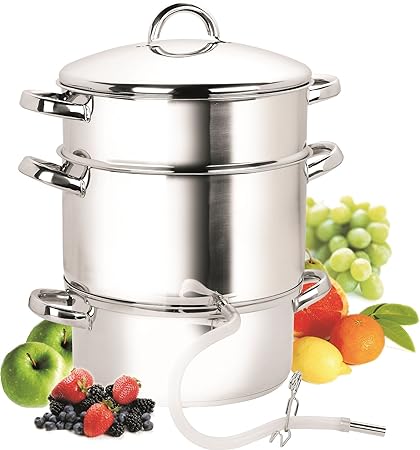- Joined
- Dec 28, 2009
- Messages
- 5,257
- Reaction score
- 557
Apparently the induction cooktop doesnt like my Stainless Steamer...

Apparently the induction cooktop doesnt like my Stainless Steamer...
Truely stainless. The induction cooktop requires at least a dmall amount of metalic metal in order to trigger the on switch.
Where did you get that nice STEAMER? I want one LOL.

Thats what I meant to say, it need to be magnetic. Of course stainless is metalic ... lol
Okay, that makes sense!
Geek alert! I am going to be geeky for a moment and discuss the magnetism of stainless steel. Please just ignore this if not interested. I fully understand that almost no one will care, and it has almost nothing to do with elderberry winemaking, but I am stuck inside until this rain lets up!
The magnetism (or lack thereof) in steel and stainless is interesting. Normally, metal atoms "want" to be as close together as possible, and so adopt a crystal structure (that is, the arrangement of the atoms) that allows this. There are two such structures, but we will only deal here with the one called face-centered cubic (FCC).
You would naively expect pure iron to be FCC to allow the atoms to pack as closely together as possible. However, there is one problem: iron atoms (Fe) have a magnetic moment, and the FCC structure does NOT allow these magnetic moments to all line up. (Magnetic moments "want" to line up, that is, they have lower energy that way.) Therefore, it turns out to be more favorable (lower in energy) for the atoms to take on a different crystal structure, called body-centered cubic (BCC), even though the atoms are not packed in as closely as possible. The consequent alignment of the magnetic moments of each atom makes iron ferromagnetic.
[Note to experts: I am not going to go into the addition of carbon to iron to make steel, i.e., pearlite, cementite, etc. Even in steel, it is the remaining FCC iron that makes it ferromagnetic.]
Now, how do you make stainless steel? You start adding nickel (Ni) and or chromium (Cr) to the regular iron steel. This makes the steel "stainless" because the oxides of Ni and Cr form a layer on top of the steel that prevents further oxidation. (This is why the wires in your toaster, for example, are a Ni-Cr alloy.)
However, Ni and Cr have much smaller magnetic moments than Fe does. If you add enough Ni and/or Cr, the energetic "payoff" from having the atoms arranged in a BCC structure (to allow the alignment of the magnetic moments) is no longer sufficient to overcome the energetic payoff of allowing the atoms to pack more closely in an FCC structure. Thus, the atoms rearrange into an FCC structure, and the magnetic moments are scrambled, and you lose the ferromagnetism. This is how the 300 series of stainless steel is formed.
However, if you add only a little Ni, the BCC structure remains. (Many of the 400 series grades of stainless are made this way.) Because the BCC structure remains, the magnetic moments can all align, and the material will be ferromagnetic.
Because of the low Ni content, 400 series stainless is cheaper to make. It is appropriate for applications where only mild resistance to oxidation is needed, like furniture or the skin of stainless steel kitchen appliances. So, if you have ever wondered why refrigerator magnets stick to some stainless steel refrigerators, but not others, well, now you know!
Here are some initial numbers.... SG = 1.016, ph = 3.87 and ta = .5703% . I was a little surprised by the ph and ta numbers so I calibrated my ph meter and check again. They were accurate.
What surprised you about these numbers?? They seem about what I would expect, I have always had to add some acid to my elderberry wine to get it to a fairly normal 3.3 or 3.4 ph. I don't generally worry much about the TA, so I don't have those numbers off the top of my head.
Enter your email address to join: